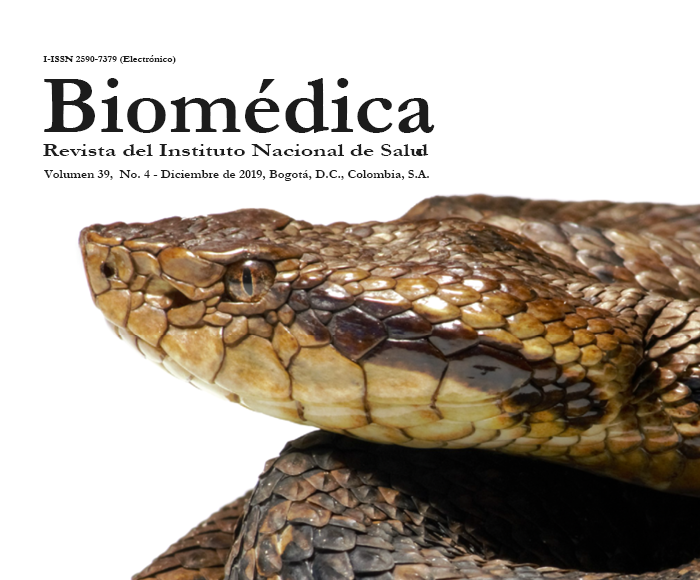Recovery of aerobic and anaerobic bacteria from patients with acute appendicitis using blood culture bottles
Abstract
Introduction: Acute appendicitis is the first cause of acute abdomen, however, there is a little information about the associated bacteria and its sensibility profile.
Objetive: To identify and to determine the resistance pattern of aerobic and anaerobic bacteria isolated in periapendicular fluid cultures taken in patients with acute appendicitis and to establish the proportions of isolates according to the clinical phase.
Materials and methods: A descriptive and prospective study was undertaken at the Hospital Universitario de San José (Bogotá, Colombia) of patients older than sixteen years of age, undergoing an open appendectomy. A sample of periappendiceal fluid was taken, which was deposited directly into aerobic and anaerobic blood culture bottles.
Results: One hundred and fifty-four patients were included. The overall positivity of cultures was 87% (n=1344); 77% (n=118) for aerobes and 51% (n=79) for anaerobes. The proportion of positive cultures was lower in the uncomplicated appendicitis cases as compared to the complicated ones (80% (66/83) vs. 95%(67/71), p = 0.003). The microorganisms isolated most frequently were: Escherichia coli (53%) (n=84); Bacteroides spp. (25%) (n=25); Propionibacterium acnes (21%) (n=21); coagulase negative
Staphylococci (17%) (n=27); Enterococcus spp. (11%) (n=15), and Fusobacterium spp. (11%) (n=11). The sensitivity of E. coli to ampicillin/sulbactam was 30%. The sensitivity of Bacteroides spp. to clindamycin and ampicillin/sulbactam was 91%. All anaerobe isolates were sensitive to piperacillin/tazobactam, ertapenem, meropenem and metronidazole.
Conclusions: Intraoperative cultures in acute appendicits are relevant in order to determine the local epidemiological pattern and to establish prophylactic and therapeutic antibiotics for this pathology; direct inoculation in blood culture bottles allows a high recovery of microorganisms.
Downloads
References
Flum D. Acute appendicitis --Appendectomy or the “Antibiotics first” strategy. N Engl J Med. 2015;372:1937-43. https://doi.org/10.1056/NEJMcp1215006
Bauer T, Vennits B, Holm B, Hahn-Pedersen J, Lysen D, Galatius H, et al. Antibiotic prophylaxis in acute nonperforated appendicitis. The Danish Multicenter Study Group III. Ann Surg. 1989;209:307-11.
Grupo para el Control de la Resistencia Bacteriana de Bogotá (GREBO). Resultados de la vigilancia de la resistencia bacteriana año 2015 – Componente pediátrico y adulto. Boletín Informativo Número 8. Bogotá, D.C.: GREBO; 2016. Fecha de consulta: 9 de febrero de 2017. Disponible en: http://www.grebo.org/grebo_site/jgrebo/documentos/Boletin_informativo_2015_2016.pdf
Brook I. Spectrum and treatment of anaerobic infections. J Infect Chemother. 2016;22:1-13. https://doi.org/10.1016/j.jiac.2015.10.010
Vallejo M, Cuesta DP, Flórez LE, Correa A, Llanos C, Isaza B, et al. Características clínicas y microbiológicas de la infección intra-abdominal complicada en Colombia: un estudio multicéntrico. Rev Chil Infectol. 2016;33:261-7. https://doi.org/10.4067/S0716-10182016000300002
Diaz S, Ríos D, Solórzano F, Calle C, Penagos D, Matallana R, et al. Microbiología de la peritonitis secundaria adquirida en la comunidad, Clínica CES. Rev Colomb Cir. 2012;27:40-5.
Solomkin JS, Mazuski JE, Bradley JS, Rodvold KA, Goldstein EJ, Baron EJ, et al. Diagnosis and management of complicated intra-abdominal infection in adults and children: Guidelines by the Surgical Infection Society and the Infectious Diseases Society of America. Clin Infect Dis. 2010;50:133-64. https://doi.org/10.1086/649554
Clinical and Laboratory Standards Institute (CLSI). Performance standards for antimicrobial susceptibility testing. Twenty-second informational supplement. Document M100-S22. Wayne, PA: CLSI; 2012.
Lob SH, Badal RE, Bouchillon SK, Hawser SP, Hackel MA, Hoban DJ, et al. Epidemiology and susceptibility of Gram-negative appendicitis pathogens: SMART 2008-2010. Surg Infect (Larchmt). 2013;14:203-8. https://doi.org/10.1089/sur.2012.034
Soffer D, Zait S, Klausner J, Kluger Y. Peritoneal cultures and antibiotic treatment in patients with perforated appendicitis. Eur J Surg. 2001;167:214-6.
Gladman MA, Knowles CH, Gladman LJ, Payne JG. Intra-operative culture in appendicitis: Traditional practice challenged. Ann R Coll Surg Engl. 2004;86:196-201. https://doi.org/10.1308/003588404323043346
Guillet-Caruba C, Cheikhelard A, Guillet M, Bille E, Descamps P, Yin L, et al. Bacteriologic epidemiology and empirical treatment of pediatric complicated appendicitis. Diagn Microbiol Infect Dis. 2011;69:376-81. https://doi.org/10.1016/j.diagmicrobio.2010.11.003
Jeon HG, Ju HU, Kim GY, Jeong J, Kim MH, Jun J. Bacteriology and changes in antibiotic susceptibility in adults with community-acquired perforated appendicitis. PLoS ONE. 2014;9:e111144. https://doi.org/10.1371/journal.pone.0111144
Chen CY, Chen YC, Pu HN, Tsai CH, Chen WT, Lin CH. Bacteriology of acute appendicitis and its implication for the use of prophylactic antibiotics. Surg Infect (Larchmt). 2012;13:383-90. https://doi.org/10.1089/sur.2011.135
Song DW, Park BK, Suh SW, Lee SE, Kim JW, Park JM, et al. Bacterial culture and antibiotic susceptibility in patients with acute appendicitis. Int J Colorectal Dis. 2018;33:441-7. https://doi.org/10.1007/s00384-018-2992-z
García-Marín A, Pérez-López M, Martínez-Guerrero E, Rodríguez-Cazalla L, Compañ-Rosique A. Microbiologic analysis of complicated and uncomplicated acute appendicitis. Surg Infect. 2018;19:83-6. https://doi.org/10.1089/sur.2017.210
Coccolini F, D’Amico G, Sartelli M, Catena F, Montori G, Ceresoli M, et al. Antibiotic resistance evaluation and clinical analysis of acute appendicitis; report of 1431 consecutive worldwide patients: A cohort study. Int J Surg. 2016;26:6-11. https://doi.org/10.1016/j.ijsu.2015.12.063
Akinkunmi EO, Adeyemi OI, Igbeneghu OA, Olaniyan EO, Omonisi AE, Lamikanra A. The pathogenicity of Staphylococcus epidermidis on the intestinal organs of rats and mice: An experimental investigation. BMC Gastroenterol. 2014;14:126. https://doi.org/10.1186/1471-230X-14-126
Boueil A, Guegan H, Colot J, D’Ortenzio E, Guerrier G. Peritoneal fluid culture and antibiotic treatment in patients with perforated appendicitis in a Pacific Island. Asian J Surg. 2015;38:242-6. https://doi.org/10.1016/j.asjsur.2015.03.005
Gil-Tomás J, Jover-García J, Colomina-Rodríguez J. Vigilancia de la sensibilidad antibiótica de anaerobios gramnegativos: RedMiVa 2010-2016. Enferm Infecc Microbiol Clin. 2018;36:200-1. https://doi.org/10.1016/j.eimc.2017.06.001

| Article metrics | |
|---|---|
| Abstract views | |
| Galley vies | |
| PDF Views | |
| HTML views | |
| Other views | |

























